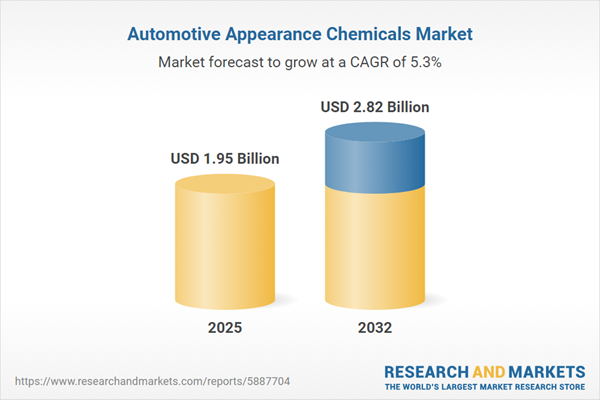Speak directly to the analyst to clarify any post sales queries you may have.
Senior leaders in the automotive appearance chemicals market face a rapidly changing environment, where adapting to sustainability requirements, regulatory evolution, and technological innovation is essential for long-term competitiveness and strategic resilience.
Market Snapshot: Automotive Appearance Chemicals Market Size and Growth Trajectory
As of 2024, the global automotive appearance chemicals market is valued at USD 1.86 billion, with anticipated growth to USD 1.95 billion by 2025 and USD 2.82 billion by 2032. Market expansion is driven by advancements in surface treatment technologies, investment in sustainable solutions, and the growing influence of vehicle electrification. Shifting product preferences foster agile business models, giving adaptable companies an advantage in navigating both regulatory and consumer-driven changes. Organizations that effectively align innovation with compliance are well-placed to realize new opportunities in this evolving landscape.
Scope & Segmentation: Automotive Appearance Chemicals Market Structure
- Product Classes: Includes cleaners, coatings, adhesives, sealants, waxes, and polishes, each aimed at improving vehicle aesthetics, protecting surfaces, and extending durability across multiple maintenance cycles.
- Vehicle Types: Solutions are tailored to commercial vehicles, passenger cars, and two-wheelers, supporting diverse needs for appearance retention, finish quality, and asset value for both fleets and individual owners.
- Technologies: Utilizes powder, solventborne, and waterborne formulations, reflecting a strategic shift toward options that address stringent environmental regulations and sustainability goals, with increasing preference for powder and water-based solutions.
- Sales Channels: Aftermarket suppliers, retail distribution, and direct OEM partnerships maintain competitive reach from initial vehicle purchase through ongoing service and maintenance, highlighting the importance of distribution efficiency and customer engagement.
- Applications: Both interior and exterior appearance chemicals contribute not only to visual enhancement but also to longer asset life, optimizing maintenance routines and sustaining value for end users across segments.
- Regional Analysis: Market behavior is shaped by varying regulatory pressures and consumer trends across regions such as the Americas, Europe, Middle East & Africa, and Asia-Pacific. Key markets including the United States, Germany, China, and India exert substantial influence on global compliance trends and innovation standards.
- Company Spotlight: Industry leaders like PPG Industries, Axalta Coating Systems, Akzo Nobel N.V., BASF SE, Sherwin-Williams, Nippon Paint Holdings, Kansai Paint, Dow Chemical, RPM International, and Hempel A/S drive ongoing research, development, and adaptive strategies in response to evolving regulatory requirements.
Key Takeaways: Strategic Insights for Senior Decision-Makers
- Integrating sustainability initiatives throughout supply chains and production processes enhances operational stability and prepares organizations for stricter compliance scenarios.
- Harnessing digital advancements such as real-time color-matching and automated controls supports faster, data-driven decisions and promotes manufacturing efficiency.
- Broadening product portfolios and evolving market entry approaches allows firms to pivot quickly as regional and consumer preferences shift.
- Collaboration between OEMs and chemical experts accelerates the introduction of advanced appearance solutions tailored for shifting manufacturer requirements and changing market demand.
- Investing in innovative coatings and sealant technologies extends product and vehicle life, reduces maintenance frequency, and increases client satisfaction for both fleet and individual clients.
- R&D dedicated to nano-based waxes and polishes supports the creation of high-performing, resource-efficient formulations, strengthening positions in both OEM and aftermarket sectors.
Tariff Impact: Implications for the U.S. Automotive Appearance Chemicals Industry
U.S. market participants are proactively addressing tariff fluctuations by increasing domestic sourcing and developing deeper partnerships with regional suppliers. This strategy supports more resilient supply chains and helps reduce potential operational disruptions from shifting international trade regulations, supporting better long-term planning and cost management.
Methodology & Data Sources
This research is grounded in industry regulatory disclosures, rigorous evaluations of components, and consultation with subject matter experts. Scenario-based segmentation guides the analysis, supporting tailored and actionable insights specifically for organizational leadership.
Why This Report Matters: Actionable Intelligence for Leadership
- Supports executives in proactively identifying and mitigating risks in the face of dynamic regulatory and customer expectations.
- Provides frameworks that empower agile adaptation to new processes and operational changes driven by industry transformation.
- Supplies leadership with effective tools for uncovering new growth opportunities and promoting long-term sustainability in resource planning.
Conclusion
This report delivers focused insights and comprehensive analysis, empowering senior leaders to fine-tune strategy, sustain competitiveness, and drive continual advancement within the automotive appearance chemicals sector.
Additional Product Information:
- Purchase of this report includes 1 year online access with quarterly updates.
- This report can be updated on request. Please contact our Customer Experience team using the Ask a Question widget on our website.
Table of Contents
3. Executive Summary
4. Market Overview
7. Cumulative Impact of Artificial Intelligence 2025
Companies Mentioned
The companies profiled in this Automotive Appearance Chemicals market report include:- PPG Industries, Inc.
- Axalta Coating Systems Ltd.
- Akzo Nobel N.V.
- BASF SE
- The Sherwin-Williams Company
- Nippon Paint Holdings Co., Ltd.
- Kansai Paint Co., Ltd.
- The Dow Chemical Company
- RPM International Inc.
- Hempel A/S
Table Information
| Report Attribute | Details |
|---|---|
| No. of Pages | 190 |
| Published | October 2025 |
| Forecast Period | 2025 - 2032 |
| Estimated Market Value ( USD | $ 1.95 Billion |
| Forecasted Market Value ( USD | $ 2.82 Billion |
| Compound Annual Growth Rate | 5.3% |
| Regions Covered | Global |
| No. of Companies Mentioned | 11 |









